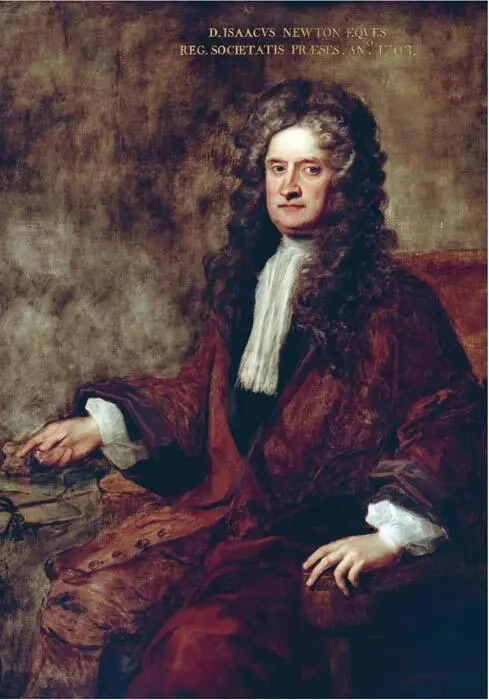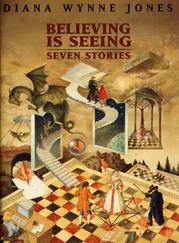
Portrait of Isaac Newton by Charles Jervas.
had been crowned King George I. The sixty-nine-year-old Leibniz, who had become unfashionable and, because of the dispute over the calculus, something of a political problem, had been left behind in Germany. He wrote a short letter to Caroline, warning her that religion was declining in England; that John Locke did not believe in the immortality of the soul; and that Sir Isaac Newton held to some strange views about the relationship between God and the physical universe.
Anyone who has blithely forwarded a private email to a corporate mailing list, with incalculable consequences, will recognise what happened next: Caroline made Leibniz’s letter known, and one Samuel Clarke stepped forward to rebut Leibniz’s charges. The result was a series of letters (five each by Leibniz and Clarke) over the course of a year, at which point Leibniz died. Clarke, though he had serious credentials in his own right both as theologian and scientist, was acting as a spokesman for Newton, and so the correspondence can fairly be read as a debate between Leibniz and Newton.
In the opening round, the combatants practically trip over each other in their eagerness to remind the Princess that atheism is bad and that true natural philosophy in no way conflicts with religion. There is no reason to think that either of them is being disingenuous. The scientific revolution had created doubts about the existence of God, or at least the veracity of religious dogma, in the minds of many; but not Newton or Leibniz.
These concerns are dispensed with in a few paragraphs. The bulk of the correspondence, which runs to about eighty pages, resembles an email exchange that devolves, as it goes on, into several distinct threads, each concerning a specific sub-topic. The correspondents begin to number their paragraphs (Leibniz’s fifth letter contains 130 of them), the better to keep track of all the rebuttals and counter-rebuttals. The over-arching theme is the relationship of God to the universe, and more specifically the universe as perceived, measured and understood by scientists. Leibniz, in the universal manner of authors promoting their latest work, finds frequent occasion to mention his books Theodicy and Monadology. Even when he isn’t mentioning them by name, he is presenting arguments, and using terminology, derived from them.
My theme is the legacy of Leibniz’s metaphysics from the time of his death down to the present day, and so a direct summary of that system, based on the scholarship of latter-day researchers, will do better service than any attempt to untangle the points and counter-points in the correspondence. The account presented below is patterned after the work of Christia Mercer of Columbia University. Her book Leibniz’s Metaphysics: Its Origins and Development, published in 2001 by Cambridge University Press, is a formidable work of forensic scholarship that can in no way be improved by my attempts to summarise it.
In 1661, at the age of fourteen, Leibniz had formed a resolution to embrace the new mechanical philosophy. For most natural philosophers of the era, this meant rejecting the Aristotelian worldview of the medieval schoolmen. As mentioned, though, Leibniz was an ecumenicist and a conciliator, and so for him it meant, rather, the beginning of a lifelong quest to reconcile certain select, precisely defined tenets of Aristotelian and Platonic thought with modern science.
In his metaphysical reasoning, Leibniz is at least as meticulous as is Newton in his mathematical physics. Bertrand Russell called Leibniz’s system ‘profound, coherent, largely Spinozistic, and amazingly logical’. Newton, however, can verify his results by comparing them to observations, while Leibniz is beholden to no one except Leibniz. By pure thinking, Leibniz fabricated a metaphysical system that could hardly be more at odds with that of Newton, or indeed any other person who attempts to think in a commonsensical way about how the world might work.
Where Newton’s work is grounded in Euclidean geometry, Leibniz begins with certain precepts that he takes to be axiomatic, such as the Principle of Sufficient Reason (nothing exists without a reason; there is no effect without a cause) and the Identity of Indiscernibles (two individual things cannot differ in number alone; it must be possible to explain why they are distinct based on some intrinsic difference). Newton developed calculus because it enabled him to solve problems in his theory of gravitation; Leibniz developed it as an outgrowth of his fascination with the problem of the Continuum, which asks how a line can be made up out of points, a span of time from instants, or a thought from the minute perceptions and endeavours of a mind. Just as Newton would not bother developing a physics that could not explain the fact that planets move in elliptical orbits, Leibniz had no time for any metaphysics that was incompatible with the transubstantiation of the Eucharist (both the Protestant and the Catholic versions!) and the incarnation of God in Christ. Much of the pick-and-shovel work of his Monadology came from a 1671 tract about the Incarnation of God. *
The modern reader, following the development of Leibniz’s ideas over the years between 1661 and his death in 1716, veers between finding it all quite reasonable and feeling as though it must have come from an alien planet. Just when one is about to judge Leibniz as having the strangest mind of anyone who ever lived, one remembers Newton and his lifelong obsession with alchemy and his strenuous efforts to predict the exact date of the End Times by ransacking the Book of Revelation for encrypted clues.
It takes an entire book such as Mercer’s to explain Leibniz’s full chain of reasoning, so there is not room here to attempt any such thing. The end point – Leibniz’s mature system, as described in Monadology – may be summarised as follows:
Matter, assumed by most to be the primary stuff of the universe, extended in space and time, is, in fact, unreal. Atomism in its conventional form – the idea that physical objects can be divided and subdivided up to a certain point, but (for some, usually unspecified, reason) no further, and that the result is a collection of tiny indivisible matter-bits moving around in empty space and banging into one another – is all wrong. The true atoms – the fundamental, indivisible units that make up the universe – are not spatiotemporal and so are not bound by spatial and temporal constraints; rather, space and time are epiphenomena of their activities, which are mental (today we might say computational) rather than physical. Leibniz calls these mind-atoms by the name of monads.
Use of ‘mind’ and ‘mental’ is apt to give modern readers the wrong idea. Many translators of Leibniz (including Russell) choose the word ‘soul’ instead of ‘mind’, which is even more confusing. A word about those words is, therefore, in order. Extension (occupying physical space) and duration (persisting through time) are obvious properties of matter that had long been of interest to natural philosophers. Beginning around 1671, Leibniz added a third element, namely cognitio, which can be translated as ‘thought’ or ‘knowledge’. In his metaphysics, cognitio is a property that things can possess and that makes them different from inert matter. Early in his career, it is as fundamental as extension. Later, it becomes more so. Previously, he had admitted God and the human mind as the only two incorporeal principles in his system; the key move he now made was to admit the possibility of cogitating entities (‘minds’ or ‘souls’) that were neither divine nor human, and to make them and ‘endeavour’ – the smallest possible unit of cogitation, which is to cognitio as a point is to a line or an instant is to time – as fundamental as space and time. Later, he goes on to deny the primary reality of space and time altogether and to assert that the created world consists entirely of these unextended monads and that the universe is created from moment to moment as a result of their cognition. In this he breaks from the metaphysics assumed by Newton (and almost anyone else who has thought in a commonsensical way about space, time and atoms) in which space and time have an absolute reality, and form a sort of lattice on which the laws of physics are enacted, and, indeed, without which they cannot even be written down.
Читать дальше













